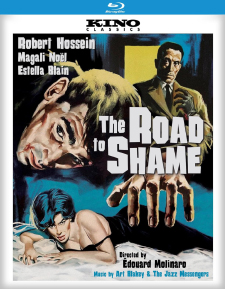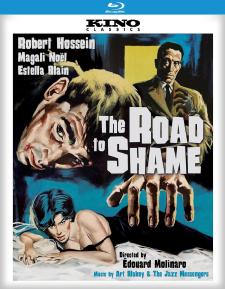Road to Shame, The (Blu-ray Review)

Director
Édouard MolinaroRelease Date(s)
1959 (February 13, 2024)Studio(s)
La Société des Films Sirius/Les Productions Jacques Roitfeld (Kino Classics)- Film/Program Grade: A-
- Video Grade: A-
- Audio Grade: A
- Extras Grade: B
Review
The Road to Shame (Des femmes disparaissent, “Women Disappear,” 1959) opens with a disclaimer arguing that its realistic depiction of sex-trafficking is absolutely necessary in order to protect women from “disgusting” criminals. The movie itself is actually much less realistic than many French crime films of this period, with an implausible storyline full of holes. But it is, undeniably, quite entertaining, with loads of effective action-suspense in every reel, and greatly enhanced by an unexpectedly delightful supporting performance from a lesser-known French actor.
Béatrice (Estella Blain) is planning a mysterious girls-night-out, angering her working-class fiancé, Pierre (Robert Hossein). He follows her to the street below the apartment of matronly dress-maker Mme. Cassini (Jane Marken), where a gaggle of young women change into fancy cocktail dresses. Pierre’s surveillance is interrupted by the arrival of two thugs, Tom (Philippe Clay) and Nasol (Pierre Collet), a confrontation between Pierre and the latter interrupted by the arrival of policemen.
The gangsters are employed by Victor Quaglio (Jacques Dacqmine), the brains behind an elaborate sex-trafficking ring. Béatrice and the other young women are taken to a remote, seaside villa by beautiful Coraline (Magali Noël), a reluctant participant in the plan. At the villa, various other gangsters employed by Quaglio masquerade as millionaire bankers, fashion designers and the like, while others work as servants for an elaborate dance and make-out party where the women are wooed and ultimately drugged.
Pierre, however, becomes a major thorn in their side. Initially, Quaglio orders Tom to kill bumbling Nasol and leave Pierre’s stolen wallet and identity papers with the corpse, assuming he’ll be blamed for the murder, but Pierre finds his way to the villa, in a series of escapes and recaptures, mostly with torpedo Tom.
The film is a very typical 1950s crime thriller in some ways, unusual in others. The moody location scenes, mostly seedy Marseille back alleys in the first part of the film, give way to an elaborate soundstage set of villa’s exteriors—tree-lined driveway, garage, steps leading to various entranceways, etc.—that become the focal point of most of the action in the last two-thirds. It’s artificial but impressively enormous, probably taking up every inch of the stage at Studios de Boulogne-Billancourt where it was shot. The nighttime setting and huge-scale police shoot-out (complete with Tommy guns and grenades) presumably necessitated this, but it does add to the film’s artifice. The action scenes are, however, quite lively.
By far the best thing about The Road to Shame is the amusing performance by Philippe Clay as gangster Tom, Quaglio’s lieutenant. Sort of a cross between Vladek Sheybal and a young Mischa Auer, Clay’s Tom seems to enjoy his work, though he becomes mildly annoyed when Pierre keeps getting away or outsmarting him. He chews gum, talks to himself, and maintains a calm, professional demeanor, even when Pierre holds him at gunpoint. I don’t recall ever encountering a gangster character quite like this in films made before or since. Despite a long film career (1950-2007) and a familiar face, and roles in major films like French Cancan (1955) The Hunchback of Notre Dame (1956), and, oddly enough, as a singer in Bell, Book and Candle (1958), this is the first time I really noticed the actor.
The picture strains credibility to the breaking point with its serial-like escape and recaptures, and especially the police unhesitatingly laying siege on the villa, knowing there are a dozen kidnapped young women inside, etc. On the other hand, it’s undeniably full of incident.
Curiously, Kino has chosen to release this as a “Kino Classics” title rather than their usual label for such older French films. The only possible explanation for this I can think of the lack of reversible cover art. The black-and-white, 1.66:1 widescreen presentation, restored in France, is excellent, though maybe a tad dark for a film set entirely over the course of one long night. The DTS-HD Master Audio (2.0 mono) is excellent, as are the English subtitles, though some of the use of modern-day profanity and other lingo in the subtitling is a little jarring. Region “A” encoded. The lone extra feature is an audio commentary track by film historian Adrian Martin.
A bit unexpectedly comic book-like considering its exposé-like promise up-front, The Road to Shame is nonetheless quite entertaining and Philippe Clay’s supporting performance really stands out. Recommended.
- Stuart Galbraith IV

